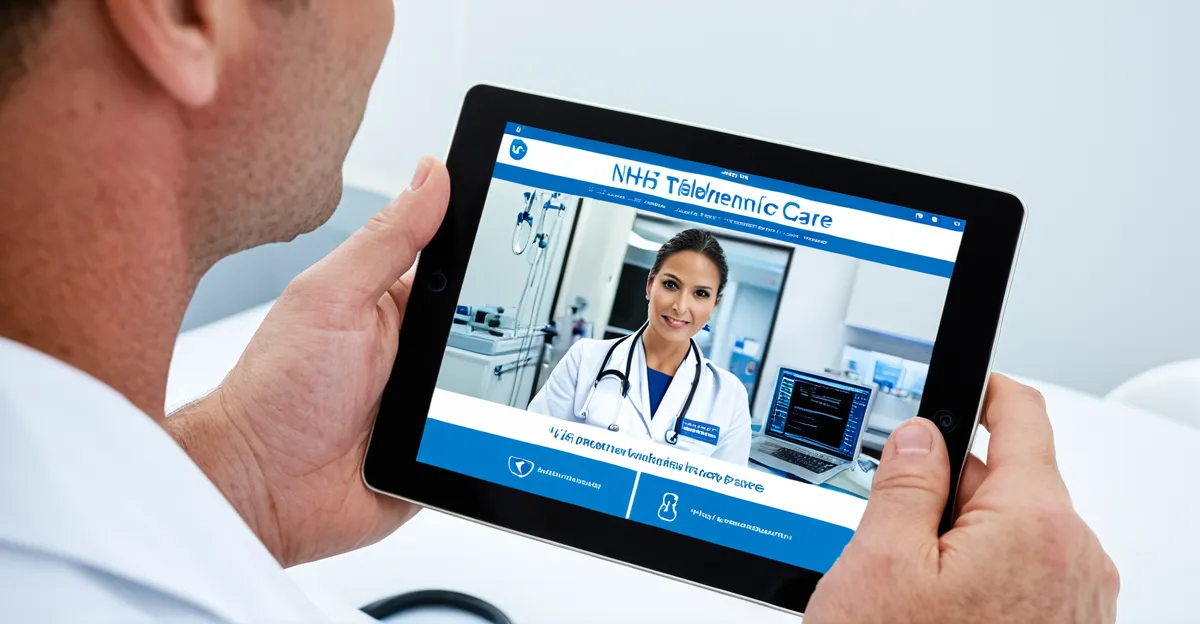Overview of NHS Telemedicine Integration Strategies
Telemedicine is increasingly becoming a cornerstone in the NHS’s strategy to enhance healthcare delivery. The NHS telemedicine integration initiatives are focused on embedding these services into everyday telehealth implementation. The current integration model is designed to improve healthcare innovation, aiming to make medical care more accessible and efficient.
In the present scenario, the NHS has embraced telemedicine in various capacities, allowing for virtual consultations and remote monitoring, which have become integral, especially during healthcare crises. The overarching goals for this integration include expanding patient access to healthcare, reducing the burden on physical healthcare infrastructure, and leveraging technology to improve healthcare outcomes.
In parallel : What Are the Potential Consequences of NHS Staff Shortages?
Numerous key stakeholders are involved in this process, including government bodies, healthcare professionals, and technology providers. These groups are essential in creating a cohesive framework for telemedicine integration. Their collaboration ensures that telehealth services are implemented effectively, overcoming challenges like technology adoption and user training.
To achieve these objectives, it is crucial that all components of this transformative strategy align towards a unified vision, proving that healthcare innovation through telemedicine is not merely aspirational but attainable.
Topic to read : How is the UK Addressing Health Inequalities Today?
Specific Initiatives and Programs
The integration of telemedicine within the NHS encompasses several telemedicine initiatives designed to revolutionize healthcare service delivery. Focusing on innovative solutions, these programs aim to bring healthcare to patients’ fingertips, enhancing accessibility and efficiency.
Telehealth Pilot Programs
The NHS has launched numerous pilot programs to test and refine telehealth services before wider implementation. These programs are strategically deployed across diverse locations, targeting various demographics to ensure comprehensive coverage and equity in healthcare. Objectives often include measuring patient satisfaction, reducing wait times, and evaluating cost-effectiveness. Success is gauged through metrics such as reduced hospital visits and enhanced patient outcomes, providing a framework for broader application.
Partnerships with Technology Providers
Collaboration with technology providers is crucial for the successful deployment of telemedicine solutions within the NHS. These partnerships involve the development and utilization of innovative tools and software tailored to the healthcare environment. Examples include platforms for secure video consultations, remote monitoring devices, and AI-powered diagnostic tools. These collaborations have a significant impact, streamlining service delivery and enhancing patient engagement with healthcare services.
Training and Resources for Healthcare Providers
To ensure effective telemedicine integration, the NHS prioritizes training and resources for its healthcare providers. Education initiatives focus on equipping staff with the necessary skills to utilize telehealth technologies confidently and effectively. Resources such as technical support, guidelines, and workshops are offered to foster both provider and patient engagement. Strategies include continuous professional development and feedback mechanisms to adapt training according to emerging needs in telemedicine practices.
Expected Benefits of Telemedicine Integration
The integration of telemedicine holds transformative potential within the NHS, primarily by enhancing patient care and increasing healthcare access. One of the most significant benefits is the ability to reach patients in remote areas who previously faced barriers accessing medical services. Telehealth services allow patients to consult with healthcare providers from the comfort of their homes, reducing the necessity for travel and thereby expanding access to healthcare.
Additionally, telemedicine can potentially reduce waiting times for medical consultations, a long-standing challenge within the NHS. As more patients opt for remote consultations, pressure on physical healthcare facilities diminishes, leading to more efficient service delivery. This shift not only helps manage patient load but also improves the overall functioning of healthcare systems.
Patient satisfaction is another crucial benefit, as telemedicine offers convenient and timely access to care. Studies have shown improved health outcomes when patients engage in regular monitoring and consultations, made possible through telehealth technology. The flexibility and immediacy of these services often lead to higher patient contentment and better adherence to medication regimens.
Incorporating telemedicine can also foster innovation in healthcare by utilizing AI and other advanced technologies to enhance diagnostic accuracy and treatment plans. This evolution in patient management ensures that the NHS remains at the forefront of healthcare delivery, adapting to changing patient needs and technological advancements. As these services become more refined, the ultimate goal is to provide comprehensive and equitable healthcare to all NHS patients.
Challenges and Barriers to Integration
While NHS telemedicine integration offers numerous opportunities, several challenges and barriers must be addressed for successful implementation. At the forefront are technical challenges that complicate the deployment of telemedicine services. These include issues such as connectivity problems in rural areas, which hinder the effectiveness of remote consultations. Ensuring reliable digital infrastructure is essential for providing consistent telehealth services.
Patient resistance is another hurdle, often rooted in the digital divide. Some patients, particularly older adults, might be reluctant to adopt technology-based healthcare solutions due to unfamiliarity or distrust of digital platforms. Bridging this gap requires targeted education initiatives aimed at increasing digital literacy and encouraging broader acceptance.
Regulatory and funding hurdles present further obstacles. The integration process is often slowed by complex regulations that govern patient data privacy and telemedicine reimbursement. Additionally, securing sustainable funding is crucial to maintaining telehealth services long-term. To surmount these challenges, collaborative efforts among stakeholders are vital to create supportive policies and secure necessary financial resources. By addressing these barriers to implementation, the NHS can ensure telemedicine becomes a seamless part of healthcare services.
Case Studies and Success Stories
The integration of telemedicine within the NHS has yielded numerous success stories, highlighting its transformative potential in healthcare service delivery. By showcasing concrete examples, we can better understand the effectiveness of telemedicine case studies and glean insights for future implementations.
Successful Implementation Examples
Several regions and hospitals across the UK have set benchmarks by successfully implementing telemedicine solutions. For instance, hospitals in rural areas have adopted virtual consultation programs, which significantly improved patient access to healthcare services. Metrics indicate a reduction in travel for patients, lowering healthcare costs and boosting satisfaction levels.
Furthermore, initiatives at urban hospitals have showcased how technology can enhance care delivery. These examples provide valuable lessons learned that can guide future telemedicine initiatives. Embracing telehealth reduces strain on physical facilities, pointing towards a model that ensures equitable healthcare access.
Comparative Analysis with Traditional Care Models
When comparing telemedicine with traditional healthcare models, notable distinctions in service delivery emerge. Telemedicine offers flexibility and convenience, lacking in conventional methods. Statistical analyses support this, demonstrating shorter wait times and improved patient engagement.
Patients often report higher satisfaction levels with telemedicine, appreciating the convenience of accessing care without leaving their homes. Expert testimonials frequently commend these systems for their efficiency, noting significant improvements over traditional care models. Such comparative insights affirm telemedicine’s effectiveness and underscore its growing role in the NHS’s strategic healthcare evolution.
Future Directions and Timelines
The journey of NHS telemedicine is set to evolve with strategic plans aimed at refining and expanding its reach. Upcoming phases include the integration of cutting-edge technologies such as AI to enhance diagnostic capabilities, further supporting providers in delivering timely care. These advancements promise to make telemedicine an even more integral part of healthcare delivery.
Looking towards the future, the NHS has laid out long-term goals which focus on achieving a more sustainable healthcare model. This includes widening the scope of telemedicine to cover a broader spectrum of services, thereby increasing patients’ ability to receive care remotely.
To ensure the success of these initiatives, continuous evaluation of telehealth efficacy is crucial. This involves assessing patient engagement, healthcare outcomes, and the adaptability of technologies used. By maintaining a cycle of review and adaptation, the NHS commits to refining its telemedicine strategies to meet future healthcare challenges and patient needs.
In summary, the strategic roadmap for NHS telemedicine is designed to sustain healthcare evolution, placing a strong emphasis on innovation and responsiveness to emerging demands. As these plans unfold, they will shape the landscape of healthcare access and delivery, ensuring that both providers and patients remain at the forefront of medical advancements.




